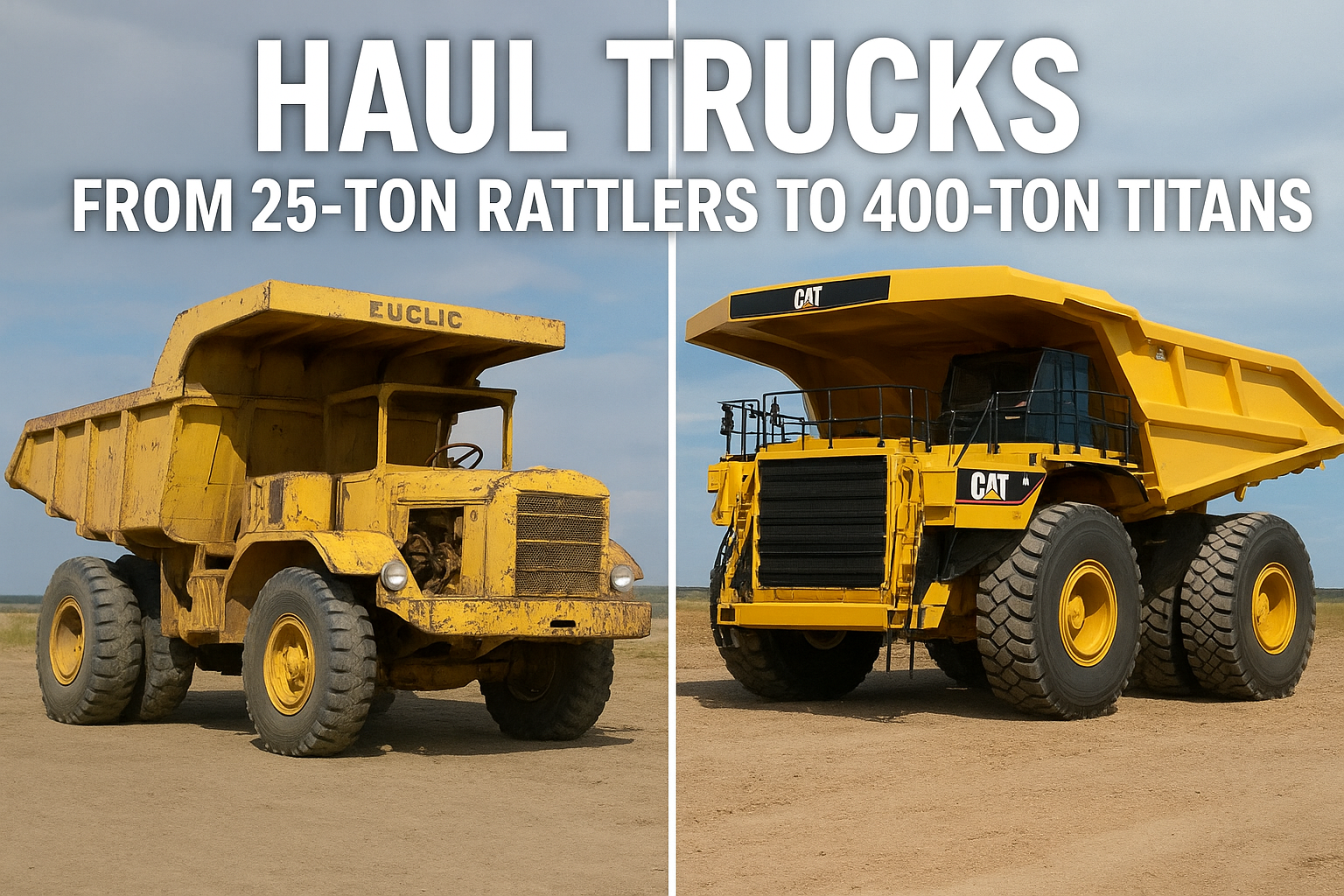Iron Insights
Haul Trucks: From 25-Ton Rattlers to 400-Ton Titans
Few machines embody the scale of mining and earthmoving like the haul truck. These giants are the backbone of open-pit operations, hauling millions of tons of rock, ore, and overburden every year. But the haul trucks of today look nothing like the ones that first rattled across job sites decades ago. Let’s dig into the evolution — from 25-ton workhorses to 400-ton marvels of modern engineering.
Then: The 25-Ton Rattlers
The roots of the modern haul truck trace back to the 1930s–1950s, when companies like Euclid (later part of GM and eventually Terex) pioneered off-road dump trucks.
- Iconic models: The Euclid R15 and R22 were early staples. The R15 could haul about 15 tons, powered by a gasoline engine in its first versions before diesels became standard. The R22 bumped capacity to about 22–25 tons.
- Powertrains: Most early trucks used direct-drive mechanical transmissions paired with naturally aspirated diesel engines producing 150–250 hp. That was enough to move loads, but uphill climbs were slow, often topping out at under 15 mph.
- Operator environment: The cabs were open or semi-enclosed, with no ROPS. Suspension systems were rudimentary — leaf springs or rigid mounts — and the trucks earned the nickname “rattlers” because they shook both machine and operator relentlessly on uneven haul roads.
- Braking systems: Mechanical or air brakes struggled with heavy loads on long grades, and runaway trucks were a real hazard.
- Durability: What they lacked in comfort, they made up for in toughness. These trucks could take punishment on primitive haul roads, though maintenance was constant.
Running these early trucks was as much an act of grit as skill. Operators wore ear protection, heavy gloves, and sometimes even strapped themselves in with makeshift harnesses before ROPS became standard in the late 1960s.
Now: The 400-Ton Titans
Fast forward to today, and haul trucks have scaled up in every possible way.
- Iconic models: The Caterpillar 797F, Komatsu 980E-5, and Liebherr T 284 dominate modern mining. Payload capacities range from 360 to 400 tons, and the trucks stand over 20 feet tall at the cab.
- Powerplants: Modern ultra-class trucks use diesel-electric drive systems. A massive diesel engine (such as the Cat 797F’s 20-cylinder, 4,000+ hp engine) powers generators, which in turn drive electric wheel motors. This setup improves torque, reduces drivetrain wear, and offers smoother performance on grades.
- Suspension & ride quality: Advanced suspension systems with nitrogen-charged hydraulic cylinders absorb shocks, preventing the bone-rattling rides of the past. Cabs are sealed, climate-controlled, and equipped with air-suspension seats.
- Safety systems: Standard ROPS/FOPS structures, multiple braking systems (dynamic retarding, hydraulic service brakes, and mechanical parking brakes), and collision-avoidance sensors keep both machine and operator safer than ever.
- Automation: Mines in Australia, Chile, and Canada already operate fleets of autonomous haul trucks, guided by GPS, LiDAR, and radar. These driverless giants run around the clock, with supervisors monitoring them remotely from control centers.
- Efficiency: Where an R22 moved 22 tons at ~12 mph, a modern 797F hauls 400 tons at 40 mph, with far greater reliability and efficiency.
For today’s operators (when human operators are still used), the cab is more cockpit than truck seat: touchscreen displays, joystick controls, and real-time diagnostics replace the noisy, bare-bones controls of the past.
Why It Matters
The leap from 25 tons to 400 tons isn’t just about bigger trucks — it’s about rethinking productivity, safety, and efficiency.
- Then: Dozens of small trucks and long shifts of rough labor.
- Now: Fewer ultra-class trucks move far more material with greater fuel efficiency per ton, less downtime, and far better protection for the people (or AI systems) running them.
Haul trucks are no longer just machines; they’re complex systems that embody decades of engineering progress.
The Bottom Line
From the Euclid R22 rattlers that shook their operators to today’s Cat 797F titans that haul 400 tons with digital precision, haul trucks have transformed from rugged workhorses into technological marvels.
Then and now, these giants remain the muscle behind the biggest jobs on earth.

